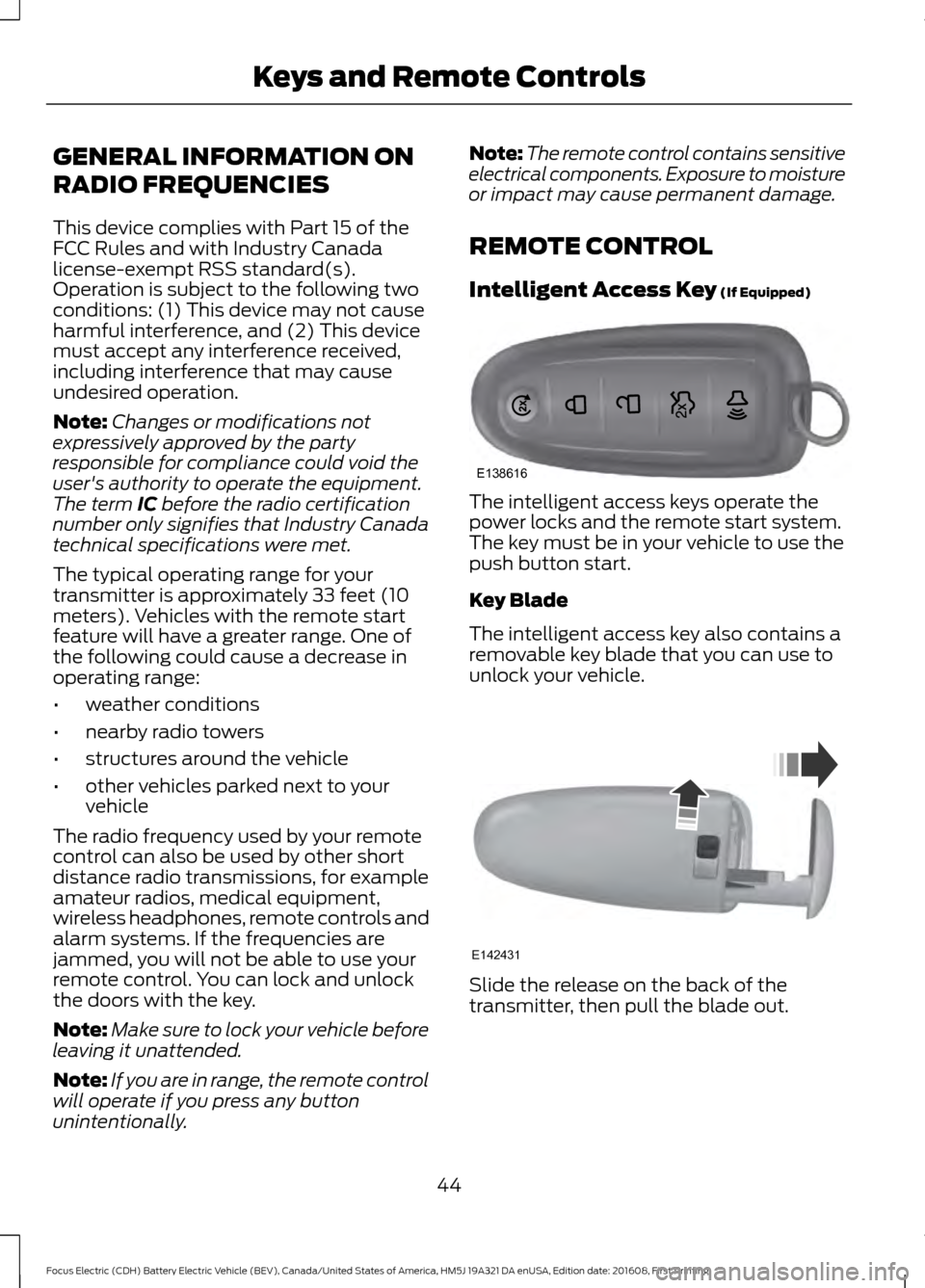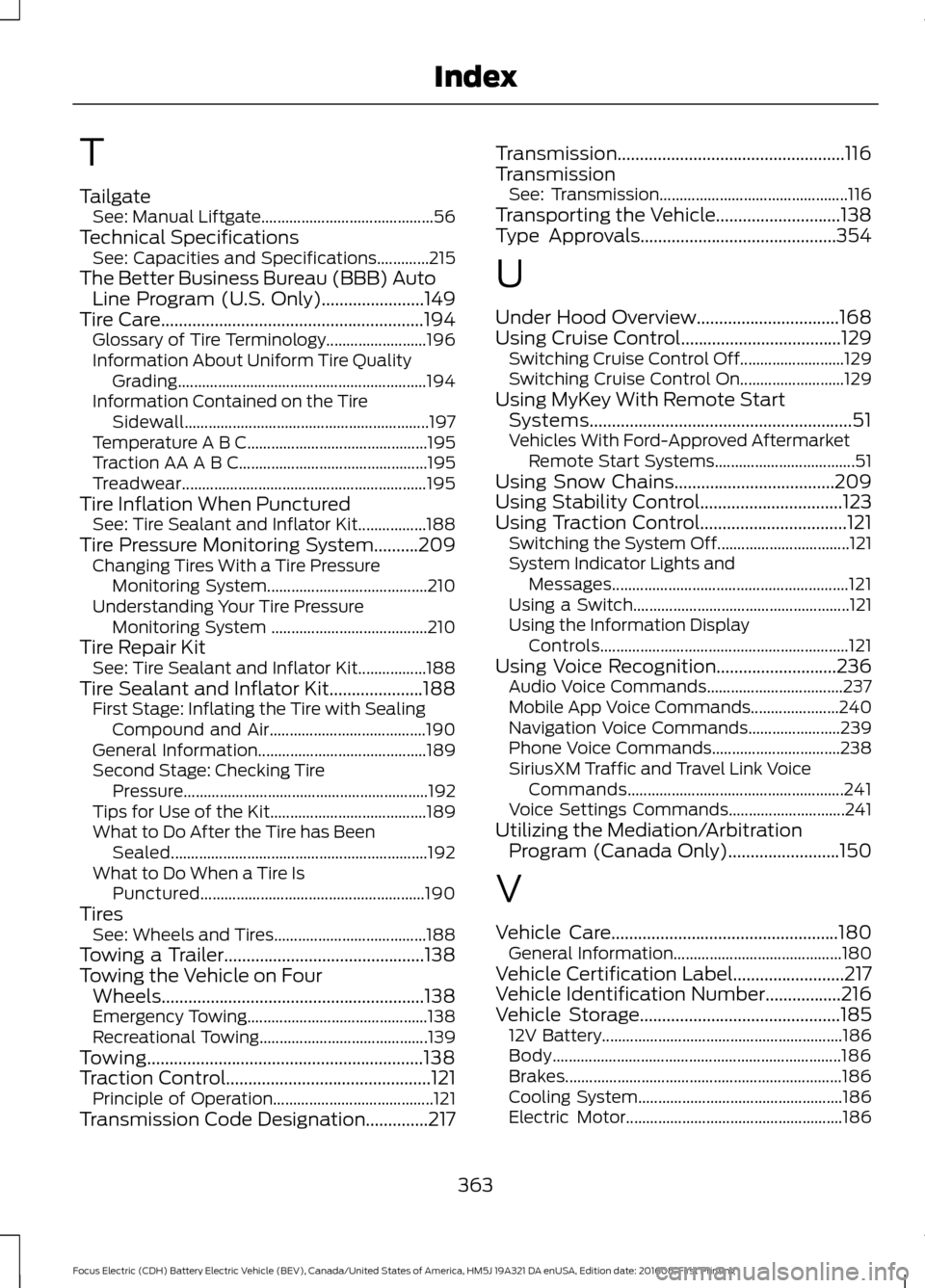2017 FORD FOCUS ELECTRIC technical specifications
[x] Cancel search: technical specificationsPage 47 of 367

GENERAL INFORMATION ON
RADIO FREQUENCIES
This device complies with Part 15 of the
FCC Rules and with Industry Canada
license-exempt RSS standard(s).
Operation is subject to the following two
conditions: (1) This device may not cause
harmful interference, and (2) This device
must accept any interference received,
including interference that may cause
undesired operation.
Note:
Changes or modifications not
expressively approved by the party
responsible for compliance could void the
user's authority to operate the equipment.
The term IC before the radio certification
number only signifies that Industry Canada
technical specifications were met.
The typical operating range for your
transmitter is approximately 33 feet (10
meters). Vehicles with the remote start
feature will have a greater range. One of
the following could cause a decrease in
operating range:
• weather conditions
• nearby radio towers
• structures around the vehicle
• other vehicles parked next to your
vehicle
The radio frequency used by your remote
control can also be used by other short
distance radio transmissions, for example
amateur radios, medical equipment,
wireless headphones, remote controls and
alarm systems. If the frequencies are
jammed, you will not be able to use your
remote control. You can lock and unlock
the doors with the key.
Note: Make sure to lock your vehicle before
leaving it unattended.
Note: If you are in range, the remote control
will operate if you press any button
unintentionally. Note:
The remote control contains sensitive
electrical components. Exposure to moisture
or impact may cause permanent damage.
REMOTE CONTROL
Intelligent Access Key
(If Equipped) The intelligent access keys operate the
power locks and the remote start system.
The key must be in your vehicle to use the
push button start.
Key Blade
The intelligent access key also contains a
removable key blade that you can use to
unlock your vehicle.
Slide the release on the back of the
transmitter, then pull the blade out.
44
Focus Electric (CDH) Battery Electric Vehicle (BEV), Canada/United States of America, HM5J 19A321 DA enUSA, Edition date: 201608, First Printing Keys and Remote ControlsE138616 E142431
Page 355 of 367

GRACENOTE SERVERS OR GRACENOTE
CONTENT. GRACENOTE COLLECTIVELY
AND SEPARATELY RESERVE THE RIGHT
TO DELETE DATA AND/OR CONTENT
FROM THE COMPANIES' RESPECTIVE
SERVERS OR, IN THE CASE OF
GRACENOTE, CHANGE DATA
CATEGORIES FOR ANY CAUSE THAT
GRACENOTE DEEMS SUFFICIENT. NO
WARRANTY IS MADE THAT EITHER
GRACENOTE CONTENT OR THE
GRACENOTE SOFTWARE OR
GRACENOTE SERVERS ARE ERROR-FREE
OR THAT THE FUNCTIONING OF THE
GRACENOTE SOFTWARE OR
GRACENOTE SERVERS WILL BE
UNINTERRUPTED. GRACENOTE IS NOT
OBLIGATED TO PROVIDE YOU WITH ANY
ENHANCED OR ADDITIONAL DATA TYPES
THAT GRACENOTE MAY CHOOSE TO
PROVIDE IN THE FUTURE AND IS FREE
TO DISCONTINUE ITS ONLINE SERVICES
AT ANY TIME. GRACENOTE DISCLAIM ALL
WARRANTIES EXPRESS OR IMPLIED,
INCLUDING, BUT NOT LIMITED TO,
IMPLIED WARRANTIES OF
MERCHANTABILITY, FITNESS FOR A
PARTICULAR PURPOSE, TITLE, AND
NON-INFRINGEMENT. NEITHER
GRACENOTE WARRANTS THE RESULTS
THAT WILL BE OBTAINED BY YOUR USE
OF THE GRACENOTE SOFTWARE OR ANY
GRACENOTE SERVER. IN NO CASE WILL
GRACENOTE BE LIABLE FOR ANY
CONSEQUENTIAL OR INCIDENTAL
DAMAGES OR FOR ANY LOST PROFITS
OR LOST REVENUES FOR ANY REASON
WHATSOEVER. © Gracenote 2007.
Radio Frequency Statement
FCC ID: ACJ-SYNCG3-L
IC: 216B-SYNCG3-L
This device complies with Part 15 of the
FCC Rules and with RSS-210 of Industry
Canada. Operation is subject to the
following two conditions:
(1) This device may not cause harmful
interference, and
(2)
this device must accept any
interference received, including
interference that may cause undesired
operation.
Note: Changes or modifications not
expressly approved by the party responsible
for compliance could void the user's
authority to operate the equipment. The
term "IC" before the radio certification
number only signifies that Industry Canada
technical specifications were met.
The antenna used for this transmitter must
not be co-located or operating in
conjunction with any other antenna or
transmitter.
Taiwan Territory
Note: In accordance with the management
approach of low-power radio wave
radiation motors:
Article 12: For approved and certified
low-power radiation motor models,
companies, firms or users must not alter
the frequency, increase the power or
change the characteristics and functions
of the original design without authorization.
Article 14: The usage of low-power
radio-frequency motors must not affect
aviation safety and interfere with legal
telecommunications. Should interference
be detected, immediately stop using the
device and only resume usage after
ensuring that there is no longer any
interference. For the legal
telecommunication and wireless
telecommunication of the telco, the
low-power radio frequency motor must be
able to tolerate legal limits of interference
from telecommunication, industrial,
scientific and radio wave equipment.
352
Focus Electric (CDH) Battery Electric Vehicle (BEV), Canada/United States of America, HM5J 19A321 DA enUSA, Edition date: 201608, First Printing Appendices
Page 366 of 367

T
Tailgate
See: Manual Liftgate........................................... 56
Technical Specifications See: Capacities and Specifications.............215
The Better Business Bureau (BBB) Auto Line Program (U.S. Only).......................149
Tire Care...........................................................194
Glossary of Tire Terminology......................... 196
Information About Uniform Tire Quality Grading.............................................................. 194
Information Contained on the Tire Sidewall............................................................. 197
Temperature A B C............................................. 195
Traction AA A B C............................................... 195
Treadwear............................................................. 195
Tire Inflation When Punctured See: Tire Sealant and Inflator Kit.................188
Tire Pressure Monitoring System..........209 Changing Tires With a Tire Pressure
Monitoring System........................................ 210
Understanding Your Tire Pressure Monitoring System ....................................... 210
Tire Repair Kit See: Tire Sealant and Inflator Kit.................188
Tire Sealant and Inflator Kit.....................188 First Stage: Inflating the Tire with Sealing
Compound and Air....................................... 190
General Information.......................................... 189
Second Stage: Checking Tire Pressure............................................................. 192
Tips for Use of the Kit....................................... 189
What to Do After the Tire has Been Sealed................................................................ 192
What to Do When a Tire Is Punctured........................................................ 190
Tires See: Wheels and Tires...................................... 188
Towing a Trailer.............................................138
Towing the Vehicle on Four Wheels
...........................................................138
Emergency Towing............................................. 138
Recreational Towing.......................................... 139
Towing..............................................................138
Traction Control
..............................................121
Principle of Operation........................................ 121
Transmission Code Designation..............217 Transmission...................................................116
Transmission
See: Transmission............................................... 116
Transporting the Vehicle............................138
Type Approvals............................................354
U
Under Hood Overview
................................168
Using Cruise Control....................................129 Switching Cruise Control Off.......................... 129
Switching Cruise Control On.......................... 129
Using MyKey With Remote Start Systems
...........................................................51
Vehicles With Ford-Approved Aftermarket
Remote Start Systems................................... 51
Using Snow Chains
....................................209
Using Stability Control................................123
Using Traction Control.................................121 Switching the System Off................................. 121
System Indicator Lights and Messages........................................................... 121
Using a Switch...................................................... 121
Using the Information Display Controls.............................................................. 121
Using Voice Recognition...........................236 Audio Voice Commands.................................. 237
Mobile App Voice Commands...................... 240
Navigation Voice Commands....................... 239
Phone Voice Commands................................ 238
SiriusXM Traffic and Travel Link Voice Commands...................................................... 241
Voice Settings Commands............................. 241
Utilizing the Mediation/Arbitration Program (Canada Only)
.........................150
V
Vehicle Care...................................................180 General Information.......................................... 180
Vehicle Certification Label.........................217
Vehicle Identification Number.................216
Vehicle Storage
.............................................185
12V Battery............................................................ 186
Body........................................................................\
186
Brakes..................................................................... 186
Cooling System................................................... 186
Electric Motor...................................................... 186
363
Focus Electric (CDH) Battery Electric Vehicle (BEV), Canada/United States of America, HM5J 19A321 DA enUSA, Edition date: 201608, First Printing Index